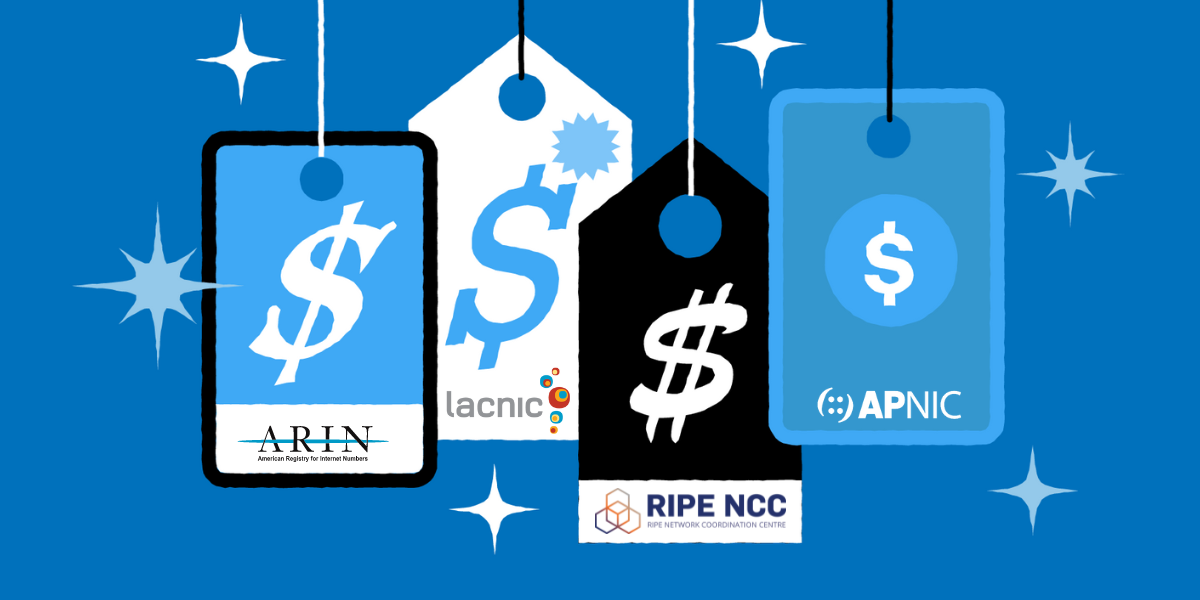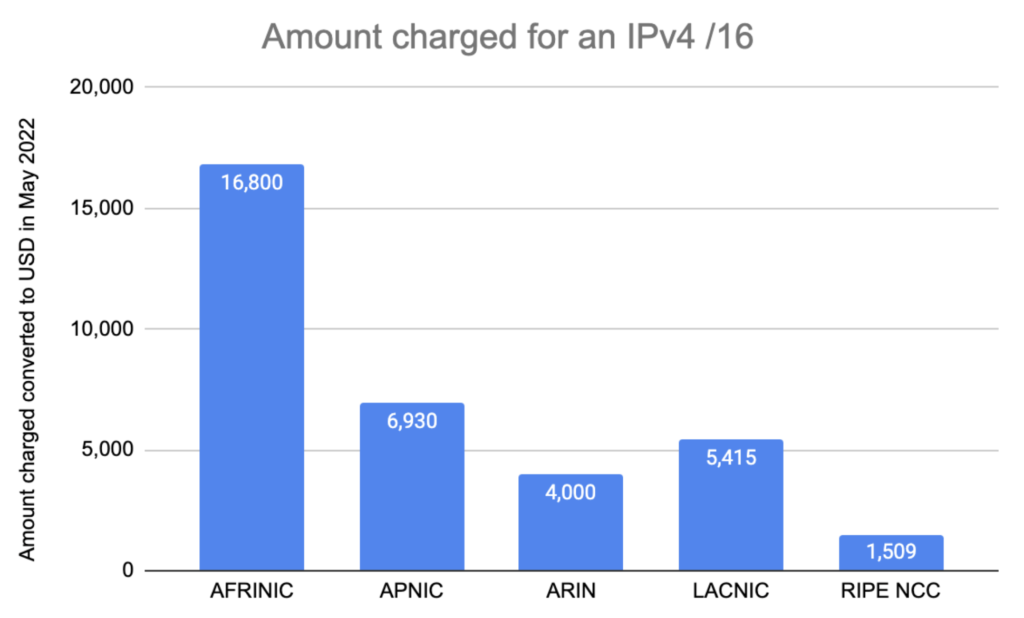IP Address Fees in 2022
By Peter Tobey & Leo Vegoda
June 21, 2022

Anything we own or control can be considered property. Land and buildings are obvious examples of this. But intangible properties like brand names and logos have value and are considered property, too.
Some of the things we regularly refer to as property are slightly more complicated. Frequently property that is intangible has control or ownership subject to terms that differ from more “normal” assets. For instance, most internet names and numbers are provided on fixed or indefinite term contracts. The contract provides a right to an entry in a register. The register is an official record of the association between the registrant and the resource.
The root registry for internet resources is the Internet Assigned Numbers Authority, or IANA. It is the root for all registers for names, numbers, and internet protocols. For instance, web traffic uses a protocol called HTTP. The HTTP protocol uses ports – the internet equivalent of a radio frequency – that have to be registered so they are not used by other protocols. IANA maintains and publishes all those protocol registries.
Each register has a manager. And those managers need to cover their costs. We have to pay registration fees for Internet Number Resources, like IP addresses and AS Numbers.
There are now five regional registries for Internet Number Resources and they charge a range of different fees.
How Did We Get Here?
Early in tlhe development of the internet, DARPA (the original, organizing body) contracted with the University of Southern California’s Information Sciences Institute, to perform all IANA functions. They registered the identifying numbers used for all interfaces (locations) on the internet. We call these numbers IP addresses. But the growth of the internet called for change.
The internet was growing up. In 1992, the National Science Foundation allowed commercial traffic on the internet. This change in policy led in two directions. Firstly, more networks from across the world would connect to the internet. Secondly, the US government did not want to pay for centralized record keeping for the domain names and IP addresses. So, US government policy pushed for privatization of the internet’s administrative needs. In October 1992, RFC 1446 called for the “distribution of the registration function” to serve “a more diverse global population.”
Internet network operators worked together to regionalize the registry function for Internet Number Resources. European operators created the RIPE NCC in April 1992. Asia-Pacific network operators formed APNIC, which started operations in January 1993.
The US government announced the privatization of the numbers registry function, through the creation of the American Registry for Internet Numbers (ARIN), in 1997.
We now have five Regional Internet Registries (RIRs) running registries for IP addresses. In some regions we also have National Internet Registries (NIRs) supporting them. National Internet Registries operate under the umbrella of an RIR but serve a specific country. This allows network operators in that country to speak to someone in their preferred language. They can also contract under local law and pay for registration services in the local currency.
There are seven NIRs in the Asia Pacific region and two in Latin America.
Latin American and Caribbean network operators formed LACNIC in 2001. It gained formal recognition in 2022. The same process followed in Africa and AFRINIC gained recognition in 2004.
What Do We Pay For?
Each RIR or NIR has its own fee schedule. They charge three main fees:
- A membership fee entitling an organization to register IP addresses and to vote
- A non-member registration fee entitling an organization to register IP addresses
- A transaction fee for any transfers they engage in
Most organizations will only pay the annual membership or non-membership fees.
Membership comes with a right to manage the RIR by voting. Organizations that rely on the smooth running of RIRs take this responsibility seriously. But some organizations are not allowed to be members of other organizations. Others just don’t want to get involved in governance.
How Do RIRs Set Their Fees?
The members of each RIR elect a board. Each year, the board proposes or sets a fee schedule. In some regions the RIR has authority to set fees itself. In other regions, the board proposes a fee schedule to its members and they vote on it.
Some people would see setting fees for IP addresses as a boring activity. But the diverse global population foreseen in RFC 1446 exists. Changes in the size of fees and the ways they are charged can generate significant interest from the internet’s multi-stakeholder community.
How Much Do We Pay?
This chart shows what each of the RIRs would charge in 2022 for 65,000 IPv4 addresses, often known as a Class B.
Both the composition of the fee schedules and the size of the fees differs dramatically between RIRs. The RIPE NCC has abandoned differentiated fees for one low fee paid by everyone. In contrast, APNIC has a base fee and applies additional fees and discounts based on how much address space an organization has and where they are located.
The RIRs review their fees each year. Fees are likely to go up in 2023.

AFRINIC
AFRINIC has seven levels of membership fee and seven levels of fees for the Internet Number Resources it manages. These range from a combined USD3,150 to USD48,400.
Non-member organizations pay between USD200 and USD2,500 each year.
AFRINIC policy only allows for transfers resulting from mergers and acquisitions.
APNIC
APNIC charges a base membership fee of AUD1,180. It then applies a formula that accounts for how much address space an organization holds. It halves this fee for organizations based in the Least Developed Countries.
The smallest annual fee is AUD1,180. A /16, also known as a Class B, would cost AUD9,626.
There is a AUD500 sign-up fee.
APNIC charges a fee for transfers. It charges 20% of the annual membership fee for a block of that size.
ARIN
ARIN has capped its fees to holders of legacy resources to USD150 in 2022. It has stated that it will raise the cap by USD25 a year.
It has 11 fee levels for organizations that have signed its registration services plan. These range from USD250 to USD256,000.
ARIN charges USD500 for transfers.
LACNIC
LACNIC has 23 fee levels for member organizations with IPv4 resources. These range from USD600 to USD365,000. Non-members pay either USD2,500 or USD5,000 for the initial assignment, depending on the size. Then, they pay USD600 each year.
LACNIC offers a discount for paying fees within 30 days.
LACNIC does not charge a transfer fee.
RIPE NCC
The RIPE NCC has a one-size-fits-all style fee schedule. Holders of legacy resources pay the same as regular members. In 2022 the flat charge is €1,000 to sign up and €1,400 for the year.
The RIPE NCC does not charge a transfer fee.
The RIPE NCC redistributes money to its membership when it has a surplus.